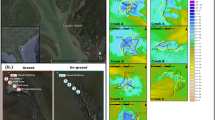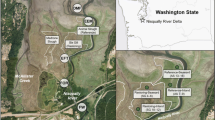Abstract
Despite theories of large-scale movement and assimilation of carbon in estuaries, recent evidence suggests that in some estuaries much more limited exchange occurs. We measured the fine-scale movement and assimilation of carbon by resident macroinvertebrates between adjacent saltmarsh and mangrove habitats in an Australian estuary using δ13C analysis of animals at different distances into adjacent patches of habitat. δ13C values of crabs (Parasesarma erythrodactyla –15.7 ± 0.1‰, Australoplax tridentata –14.7 ± 0.1‰) and slugs (Onchidina australis –16.2 ± 0.3‰) in saltmarsh closely matched that of the salt couch grass Sporobolus virginicus (–15.5 ± 0.1‰). In mangroves, δ13C values of crabs (P. erythrodactyla –22.0 ± 0.2‰, A. tridentata –19.2 ± 0.3‰) and slugs (–19.7 ± 0.3‰) were enriched relative to those of mangroves (–27.9 ± 0.2‰) but were more similar to those of microphytobenthos (–23.7 ± 0.3‰). The δ13C values of animals across the saltmarsh-mangrove interface fitted a sigmoidal curve, with a transition zone of rapidly changing values at the saltmarsh-mangrove boundary. The width of this transition indicated that the movement and assimilation of carbon is limited to between 5 and 7 m. The δ13C values of crabs and slugs, especially those in saltmarsh habitat, clearly indicate that the movement and assimilation of carbon between adjacent saltmarsh and mangrove habitat is restricted to just a few metres, although some contribution from unmeasured sources elsewhere in the estuary is possible. Such evidence demonstrating the extent of carbon movement and assimilation by animals in estuarine habitats is useful in determining the spatial arrangement of habitats needed in marine protected areas to capture food web processes.
Similar content being viewed by others
References
Ayukai T., Miller D., Wolanski E. and Spagnol S. 1998. Fluxes of nutrients and dissolved and particulate organic matter in two mangrove creeks in northeastern Australia. Mangroves Saltmarshes 2: 223–230.
Bolger D.T., Suarez A.V., Crooks K.R., Morrison S.A. and Case T.J. 2000. Arthropods in urban habitat fragments in southern California: area, age and edge effects. Ecol. Appl. 10: 1230–1248.
Bouillon S., Koedam N., Raman A.V. and Dehairs F. 2002. Primary producers sustaining macro-invertebrate communities in intertidal mangrove forests. Oecologia 130: 441–448.
Boon P.I. and Bunn S.E. 1994. Variations in the stable isotope composition of aquatic plants and their implications for food web analysis. Aquat. Bot. 48: 99–108.
Burkey T.V. 1993. Edge effects in seed and egg predation at two neotropical rainforest sites. Biol. Conserv. 66: 139–143.
Chong V.C., Low C.B. and Ichikawa T. 2000. Contribution of mangrove detritus to juvenile prawn nutrition: a dual stable isotope study in a Malaysian mangrove forest. Mar. Biol. 138: 77–86.
Currin C.A., Newell S.Y. and Paerl H.W. 1995. The role of standing dead Spartina alterniflora and benthic microalgae in salt marsh food webs -considerations based on multiple stable isotope analysis. Mar. Ecol. Prog. Ser. 121: 99–116.
Dahdouh-Guebas F., Giuggioli M., Oluoch A., Vannini M. and Cannicci S. 1999. Feeding habits of non-ocypodid crabs from two mangrove forests in Kenya. Bull. Mar. Sci. 64: 291–297.
Davenport S.R. and Bax N.J. 2002. A trophic study of a marine ecosystem off southeastern Australia using stable isotopes of carbon and nitrogen. Can. J. Fish. Aquat. Sci. 59: 514–530.
Davies-Colley R.J., Payne G.W. and van Elswijk M. 2000. Microclimate gradients across a forest edge. NZ J. Ecol. 24: 111–121.
Deegan L. and Garritt R.H. 1997. Evidence for spatial variability in estuarine food webs. Mar. Ecol. Prog. Ser. 147: 31–47.
Dittel A.I., Epifanio C.E., Schwalm S.M., Fantle M.S. and Fogel M.L. 2000. Carbon and nitrogen sources for juvenile blue crabs Callinectes sapidus in coastal wetlands. Mar. Ecol. Prog. Ser. 194: 103–112.
Dye A.H. and Lasiak T.A. 1986. Microbenthos, meiobenthos and fiddler crabs: trophic interactions in a tropical mangrove sediment. Mar. Ecol. Prog. Ser. 32: 259–264.
Fagan W.E., Cantrell R.S. and Cosner C. 1999. How habitat edges change species interactions. Amer. Nat. 153: 165–182.
Flaspohler D.J., Temple S.A. and Rosenfield R.N. 2001. Speciesspecific edge effects on nest success and breeding bird density in a forested landscape. Ecol. Appl. 11: 32–46.
France R.L. 1998. Estimating the assimilation of mangrove detritus by fiddler crabs in Laguna Joyuda, Puerto Rico, using dual stable isotopes. J. Tropic. Ecol. 14: 413–425.
Fry B. 1984. 13C/12C ratios and the trophic importance of algae in Florida Syringodium filiforme seagrass meadows. Mar. Biol. 79: 11–19.
Guest M.A., Connolly, R.M. and Loneragan, N.R. 2004a. Within and among-site variability in δ13C and δ15N for three estuarine producers, Sporobolus virginicus, Zostera capricorni, and epiphytes of Z. capricorni. Aquat. Bot. 79: 87–94.
Guest M.A., Connolly R.M. and Loneragan, N.R. 2004b. Carbon movement and assimilation by invertebrates in estuarine habitats occurring at a scale of metres. Mar. Ecol. Prog. Ser. 278: 27–34.
Haines E.B. and Montague C.L. 1979. Food sources of estuarine invertebrates analysed using 13C/12C ratios. Ecology 60: 48–56.
Hemminga M.A., Slim F.J., Kazungu J., Ganssen G.M., Nieuwenhuize J. and Kruyt N.M. 1994. Carbon outwelling from a mangrove forest with adjacent seagrass beds and coral reefs (Gazi Bay, Kenya). Mar. Ecol. Prog. Ser. 106: 291–301.
Hsieh H., Chen C., Chen Y. and Yang H. 2002. Diversity of benthic organic matter flows through polychaetes and crabs in a mangrove estuary: δ13C and δ34S signals. Mar. Ecol. Prog. Ser. 227: 145–155.
Iribarne O., Bortolus A. and Botto F. 1997. Between-habitat differences in burrow characteristics and trophic modes in the southwestern Atlantic burrowing crab Chasmagnathus granulata. Mar. Ecol. Prog. Ser. 155: 137–145.
Kneib R.T. 2000. Saltmarsh ecoscapes and production transfers by estuarine nekton in the southeastern United States. In: Weinstein M.P. and Kreeger D.A. (eds), Concepts and Controversies in Tidal Marsh Ecology. Kluwer Academic Publishers, Dordrecht, pp. 267–291.
Kurata K., Minami H. and Kikuchi E. 2001. Stable isotope analysis of food sources for salt marsh snails. Mar. Ecol. Prog. Ser. 223: 267–177.
Lee S.Y. 1995. Mangrove outwelling -a review. Hydrobiologia 295: 203–212.
Lee S.Y. 1998. Ecological role of graspid crabs in mangrove ecosystems: a review. Mar. Freshwat. Res. 49: 335–343.
Lin G., Bank T. and Sternberg L.S.L.O. 1991. Variation in δ13C values for the seagrass Thalassia testudinum and its relations to mangrove carbon. Aquat. Bot. 40: 333–341.
Link J. 2002. Does food web theory work for marine ecosystems? Mar. Ecol. Prog. Ser. 230: 1–9.
Loneragan N.R., Bunn S.E. and Kellaway D.M. 1997. Are mangroves and seagrasses sources of organic carbon for penaeid prawns in a tropical Australian estuary? A multiple stable isotope study. Mar. Biol. 130: 289–300.
Marguillier S., van der Velde G., Dehairs F., Hemminga M.A. and Rajagopal S. 1997. Trophic relationships in an interlinked mangrove-seagrass ecosystem as traced by δ13C and δ15N. Mar. Ecol. Prog. Ser. 151: 115–121.
McCutchan J.H., Lewis W.M., Kendall C. and McGrath C.C. 2003. Variation in trophic shift for stable isotope ratios of carbon, nitrogen and sulfur. Oikos 102: 378–390.
Melville A.J. and Connolly R.M. 2003. Spatial analysis of stable isotope data to determine primary sources of nutrition for fish. Oecologia 136: 499–507.
Odum E.P. 1968. Evaluating the productivity of coastal and estuarine water. In: Proceedings of the Second Sea Grant Conference. University of Rhode Island, pp. 63–64.
Peterson B.J. and Fry B. 1987. Stable isotopes in ecosystem studies. Ann. Rev. Ecol. Sys. 18: 293–320.
Polis G.A., Anderson W.B. and Holt R.D. 1997. Toward an integration of landscape and food web ecology: the dynamics of spatially subsidized food webs. Ann. Rev. Ecol. Syst. 28: 289–316.
Robinson S.K., Thompson III F.R., Donovan T.M., Whitehead D.R. and Faaborg J. 1995. Regional forest fragmentation and the success of migratory birds. Science 257: 524–526.
Rodelli M.R., Gearing J.N., Gearing P.J., Marshall N. and Sasekmar A. 1984. Stable isotopes as a tracer of mangrove carbon in Malaysian ecosystems. Oecologia 61: 326–333.
SPSS for Windows. 2002. Release 11. 5.0 Standard Version. © SPSS Inc., 1989–2002.
TableCurve 2D. 2000. Automated Curve Fitting and Equation Discovery, v. 5. © AISN Software.
Weinstein M.P. and Litvin S.Y. 2000. The role of tidal saltmarsh as an energy source for marine transient and resident finfishes: a stable isotope approach. Trans. Am. Fish. Soc. 129: 797–810.
Author information
Authors and Affiliations
Rights and permissions
About this article
Cite this article
Guest, M.A., Connolly, R.M. Fine-scale movement and assimilation of carbon in saltmarsh and mangrove habitat by resident animals. Aquatic Ecology 38, 599–609 (2004). https://doi.org/10.1007/s10452-004-0442-1
Issue Date:
DOI: https://doi.org/10.1007/s10452-004-0442-1




